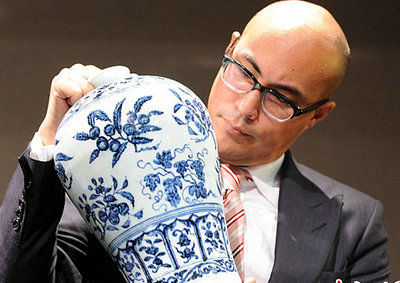 |
|
|
The biannual Sotheby's sales are considered a key indicator of the Asian art market. While ceramics and classic Chinese paintings performed solidly, the Asian and Chinese contemporary art sales showed signs of strain, with unsold work ratios of over 20 percent as the global economic uncertainty deepens.
Whilst some major lots with conspicuous cracks failed to sell, bidding was strong for a sublime blue and white "meiping" vase of fruit sprays from the Ming Yongle period that went for HK$168.7 million ($21.6 million) to a telephone bidder, a world record at auction for any piece of Chinese Ming porcelain.
"The Ming was strong this time," said William Chak, a prominent Hong Kong dealer who bought a sky-blue Yongzheng gourd vase at the sale for HK$4.6 million.
A famille-rose Qing Qianlong period "peach" vase managed to fetch HK$90.3 million ($11.6 million) in another notable result, while another bright spot was the $3.7 million bid made for an extremely rare blue and white Ming Yongle period "Jue" stand.
Ming porcelain (1368-1644), older though often less decorative and ornate than Qing (1644-1911) wares, has in recent years been relatively less desired by nouveau riche Chinese mainland buyers, meaning its prices haven't reached anywhere near the heights of dazzling late Qing trophy pieces.
There was some weakness, though, in Sotheby's other ceramics and Chinese art work sale, with a batch of a so-called premium lots - that require hefty credit guarantees in order to bid - failing to sell.
This included a Qianlong era white "phoenix" vase as well as a cinnabar lacquer "dragon" bowl that had been expected to fetch tens of millions of Hong Kong dollars.
"I think many people were worried what would happen before the sales," said Nader Rasti, an Asian art dealer. "But I think they did well considering what's going on ... 15th century porcelain has been so cheap for so long, there's a lot of good Ming porcelain that's still undervalued."
The predominantly Chinese mainland buyers present on Wednesday, who've powered the Chinese ceramics market in recent years, weren't buying indiscriminately this time round, giving rare, though flawed pieces a wide berth.
22 percent of the Meiyintang wares went unsold including two premium lots: a Ming Yongle period moonflask whose cracked neck had been entirely rebuilt and a Qing Qianlong reign famille-rose gourd flask with cracks on its handles. ($1 = 7.786 Hong Kong Dollars)





Why not rent a boyfriend, or girlfriend to please parents during the Spring Festival?